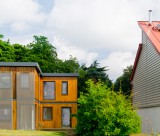The University of Nottingham
 Exchange online
Exchange online
Research Exchange
£9m for MRI in Nottingham to revolutionise research into disease

October 23 2014
When Nobel Prize winner Sir Peter Mansfield constructed the very first MRI scanner in the Physics Department at The University of Nottingham, little did he know that four decades later, his ground-breaking research would still be having a profound impact on the world of medical research and patient management.
The Government has announced it will be investing £7.7m in magnetic resonance imaging (MRI) scanning equipment at The University of Nottingham. And with another £1.67m from the University for new buildings and facilities, this huge cash injection – for the birthplace of MRI – will secure Nottingham’s position in the vanguard of MRI research internationally for the next 10 years. It will bring together renowned expertise at the Sir Peter Mansfield Magnetic Resonance Centre and translational medical studies carried out by the Medical Imaging Unit in the Faculty of Medicine and Health Sciences at the Queen’s Medical Centre, to produce a step change in clinical outcomes.
The investment is part of a major £230m initiative, ‘Enhancing UK’s Clinical Research Capabilities and Technologies’, announced today by The Chancellor of the Exchequer, George Osbourne in partnership with the Medical Research Council. It brings together funding from the UK Government, devolved administrations, Arthritis Research UK, British Heart Foundation, the Wellcome Trust and Cancer Research UK to advance clinical research.
The new centre will come under the Directorship of Professor Peter Morris of the School of Physics and Astronomy, who was Sir Peter Mansfield’s PhD student in the days when MRI was being invented. He said: “Nottingham has considerable expertise and a long track record of success in the development of MRI. It also has strong research programmes in gastroenterology, liver disease, metabolism, exercise and sports medicine, orthopaedics, respiratory medicine, neurosciences and radiology. The new centre will combine these strengths to establish a world leading centre to drive the development and application of medical imaging.”
Two Nottingham imaging centres become one
The new single centre, which will be known as the Sir Peter Mansfield Imaging Centre (SPMIC), will span the two existing sites and underpin the work of The University of Nottingham’s global research theme ‘Health and Wellbeing’.
The SPMIC will provide the very latest imaging facilities for innovative research in gastroenterology, liver disease, metabolism, muskulo-skeletal disorders, respiratory medicine, mental health, hearing and radiological sciences.
Among many other partnerships and collaborations, the centre will work closely with NIHR Biomedical Research Units in Gastrointestinal and Liver Diseases and in Hearing, the ARUK Centre for Sport, Exercise and Osteoarthritis with Oxford, the MRC-ARUK Centre for Musculoskeletal Ageing Research with Birmingham, the ARUK National Pain Centre, the Institute of Mental Health and the Respiratory Disease Research Centres.
New equipment to push the boundaries of research
Professor Ian Hall, Dean of the Faculty of Medicine and Health Sciences, said: “This award is a remarkable achievement for everyone involved. MRI has already revolutionised medical imaging but there is considerable potential for us to develop additional MR based imaging approaches which could play important roles in the management of many common diseases. The Government’s investment in Nottingham’s MRI research will ensure we remain at the forefront of developments in MRI and its applications. It will also establish the University as a lead institution within the new national 7T MRI network.”
The SPMIC will be equipped with:
- A new multi-transmit capability to expand scanning at 7T from the brain only to the whole body.
- A wide-bore 3T MR scanner for scanning larger or claustrophobic patients or those undertaking exercise studies.
- A vertical MR scanner for weight-bearing studies of the musculoskeletal system and for studying the effect of posture on gastrointestinal and lung function.
- Clinical hyperpolarisation equipment to study metabolism in the brain and body.
- Hyperpolarized gas facilities for use in the study of lung disease.
- Optical motion detection cameras for correcting errors produced in images by patient movement during scanning.
- Acoustic noise cancellation systems that will improve patient experience
- A dedicated electrophysiology laboratory close to the 7T scanner, and a nearby infra-red spectroscopy system for study of the effects of cochlear implantation.
- A new postgraduate student block and more patient-friendly facilities.
Professor Sir David Greenaway, the University’s Vice-Chancellor, said: “This funding provides the University with a unique opportunity to take our world leading expertise in MRI to the next level. It is a tribute to Sir Peter Mansfield and the teams following in his footsteps. MRI is an area that continues to evolve and is justifiably seen as one of the most important breakthroughs in medical science. We will ensure our work in this area continues to push the boundaries of diagnostics for the benefit of improved patient care.”
Speaking in Exeter, Chancellor George Osborne, said: “The UK is already a world leader in science and research, which is why at Budget, I protected science spending. Today we go a step further by announcing £150m of new investment in clinical research infrastructure. The funding will go to 23 truly innovative projects from across the UK today that represent the best of British ingenuity and scientific exploration. The Government, charities, universities and industry will be working together to advance our knowledge in combatting the biggest medical challenges of our time.”
Professor Sir John Savill, Chief Executive of the Medical Research Council, said: “The Government entrusted £150m of funding to this initiative. With generous contributions from Arthritis Research UK, the British Heart Foundation and other partners, we have been able to invest over £230m in a collaboration that will catalyse innovation and advance our knowledge in completely new areas of research.”
Life Sciences Minister George Freeman said: “We want to make the UK the best place in the world for life sciences. Building on our existing research infrastructure this investment will speed up the innovation of experimental medicine, strengthen partnerships with industry and charities and boost our economic growth in this exciting sector.”
Tags: ARUK National Pain Centre, exercise, funding, magnetic resonance imaging, Medical Research Council, MRC-ARUK Centre for Musculoskeletal Ageing Research, MRI, NIHR Biomedical Research Units, Professor Ian Hall, Professor Peter Morris, Sir Peter Mansfield, Sir Peter Mansfield Magnetic Resonance Centre, the ARUK Centre for Sport, the Institute of Mental Health, the Respiratory Disease Research Centres
Leave a Reply
Other

Top prize for quantum physicist
A University of Nottingham physicist has won a prestigious medal from the Institute of Physics for […]

Zero carbon HOUSE designed and built by students comes home
Design and construct a low cost, zero carbon, family starter home, transport it to Spain, build […]